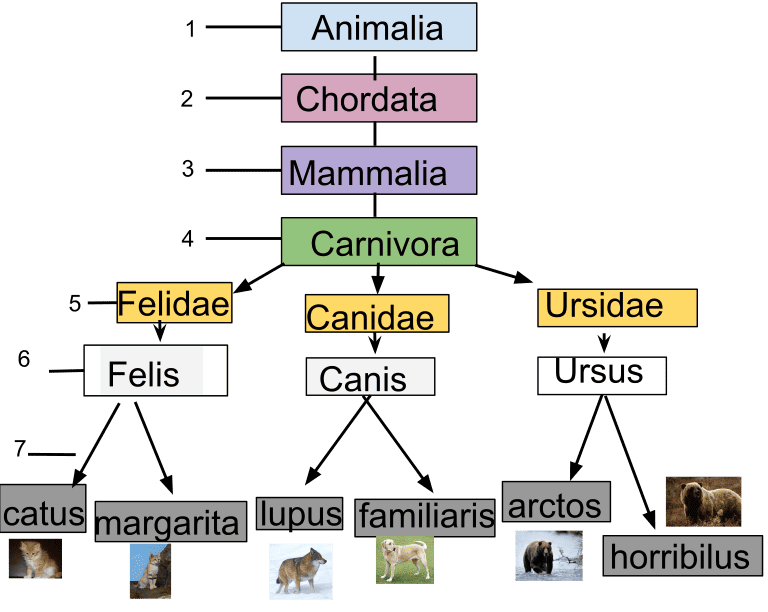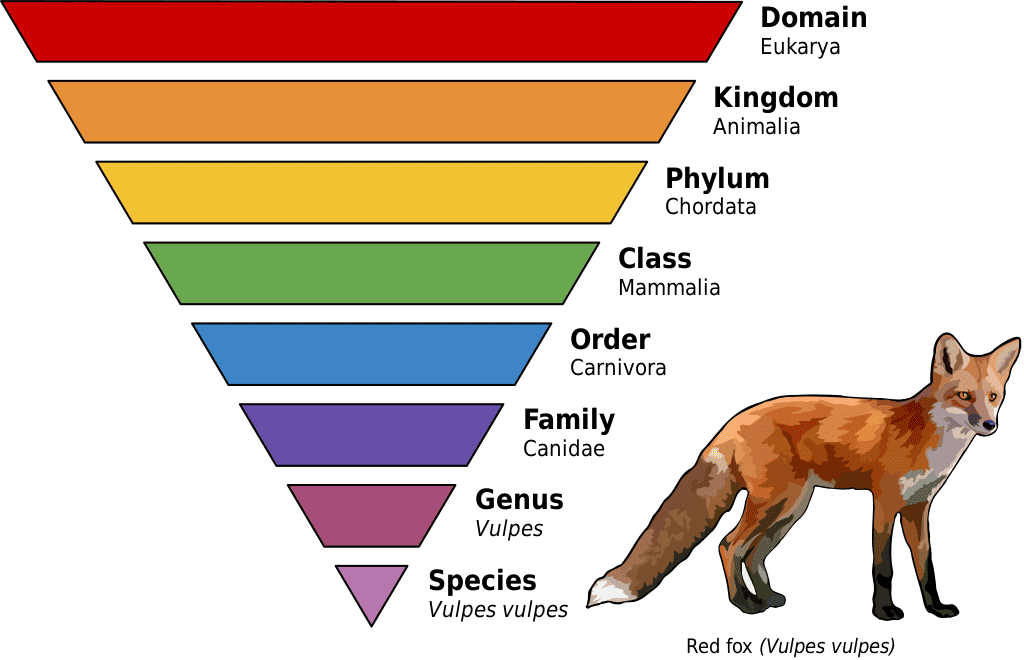Imagine your friend without a name. How could you possibly address them? Why do you call a dog a dog and not a dinosaur?
If names never existed, our world will be in a ruckus creating much more misunderstanding than there is now.
There’s a field of science all about naming and classifying organisms — it’s called taxonomy.

Defining taxonomy
Think about finding a book in a big library. How do you find it? You can organize books by author name (and they often are), but that’s not very efficient. If you have a lot of books, it first makes sense to organize them by genre — and within the genre, look by author name.
Something similar happens with biological species.
Taxonomy is the science of naming, defining and classifying evolutionarily related organisms. It is the filing system of life and we use it to identify and group organisms based on their shared morphological or physical characteristics.
This revolves around the concept that similar features descend from a common ancestor. This means categorizing taxa (classified groups) and evolutionary links which helps us to complete the story of life on Earth.
As you delve deeper into the labyrinth of life, taxonomy is the foundation of our understanding of the natural world. By giving names to organisms and arranging them into groups, taxonomists provide us with a language to talk about life, a map to navigate its complexities, and a lens to peer into its mysteries.
How taxonomy emerged
The story of taxonomy begins with the ancient Greeks, who first attempted to make sense of the living world by sorting plants and animals into categories.
Taxonomy came from the Greek word taxis, meaning arrangement or division and nomos, meaning law. This science of classification is in line with a predetermined system as the nesting goes from specific species up to genus, then up to the family, order, class, and phylum, and eventually up to the most generic classifications — kingdom and domain.
Fast forward to the 18th century, and taxonomy doesn’t truly exist yet. This is when Swedish naturalist Carl Linnaeus enters the stage.
Linnaeus transformed the field of taxonomy with his revolutionary system of classification. The result is a simple yet powerful system called binomial nomenclature.
This is a two-part naming system that assigns a unique name in Latin to each species, consisting of a genus name and a species name.

This elegant method allowed scientists to communicate clearly about the vast array of life forms they were discovering. Nowadays, biologists name all species with Linnaeus’ taxonomy.
Linnaeus had a prolific career. He named and categorized 7,700 plants and 4,400 animals. He also published all this work in his ten volume work, Systema naturae (1735-1758).
This has long been considered the beginning of modern botanical and zoological nomenclature and has helped shape up taxonomy by drawing the rules for assigning names.
How taxonomy works

All creatures have a taxonomic rank. Think of this as their hierarchy in their tree of life.
The major ranks are, in this order:
- domain
- kingdom
- phylum
- class
- order
- family
- genus
- species.
All life on Earth is split into three domains of organisms:
- Bacteria;
- Archaea (microorganisms that are fundamentally different from bacteria);
- Eukarya (all other life on Earth).
Each of these is then split into several kingdoms. For instance, the kingdoms of Eukarya are:
- Animalia (animals);
- Plantae (plants)
- Fungi (mushrooms)
- Protista (unicellular organisms).
Each kingdom is then split into phyla, which are then split into classes, which are then split into orders, which are then split into families, and only then you end up with the genus (and the species).
Yes, it’s a very complex system — but life on Earth is also complex. Classifying all life is bound to have some complexity. But for the taxonomic name, only the genus and family are used.
So the taxonomy of all species is defined by two elements: the genus (a principal taxonomic category that ranks above species) and the species.
Taxonomy examples

The genus name comes first and is always capitalized. The species name follows and is written in lowercase. Both names are italicized.
This two-part naming system ensures that each species has a distinct and recognizable identity, much like a person’s first and last name.
Here are some examples:
- Humans: Homo sapiens
- Genus: Homo
- Species: sapiens
- Dogs: Canis lupus familiaris
- Genus: Canis
- Species: lupus familiaris (subspecies of Canis lupus)
- Domestic cats: Felis catus
- Genus: Felis
- Species: catus
- Tigers: Panthera tigris
- Genus: Panthera
- Species: tigris
- Bald eagles: Haliaeetus leucocephalus
- Genus: Haliaeetus
- Species: leucocephalus
- Giant pandas: Ailuropoda melanoleuca
- Genus: Ailuropoda
- Species: melanoleuca
- Monarch butterflies: Danaus plexippus
- Genus: Danaus
- Species: plexippus
This binomial system is used not only for all the species that we know of but also for species that are newly discovered. Species are attributed to an existing genus (or in a separate genus, if they’re that different), and then given a species name.
This is usually given after a researcher or the place where they were found, but sometimes, species names can be quirky. For instance, some species are named after celebrities.
Taxonomy and the Tree of Life
Taxonomy is not just about naming species; it’s about understanding their relationships. Like unraveling the threads of a tapestry, taxonomists trace the intricate connections between organisms, revealing the grand pattern of life on Earth.
In the modern days, taxonomy and evolution are intertwined. A taxonomic group must always refer to a set of organisms that descended from the same ancestry. Aside from looking at the external and internal traits, examining genetic data has been the trend to back up classification.
In their quest to map the Tree of Life, taxonomists have developed various systems to classify organisms. Traditionally, they relied on morphology – the study of an organism’s physical characteristics, such as shape, size, and structure. However, as technology advanced, new tools became available, allowing taxonomists to peer deeper into the fabric of life.
Enter the world of molecular taxonomy, where DNA serves as the blueprint for understanding life’s diversity. By comparing the genetic sequences of different organisms, scientists can determine how closely related they are, shedding light on the evolutionary relationships between species.
The rise of molecular taxonomy marked a turning point in the field. Suddenly, taxonomists had a powerful new tool at their disposal, one that could resolve longstanding debates and reveal previously hidden connections between organisms.
Molecular data has not only refined our understanding of existing groups but has also led to the discovery of new ones, painting a more complete picture of the living world.
Taxonomy in our lives
Taxonomy is fundamental in many aspects. It provides the basics about the components of biodiversity which is vital for creating effective conservation programs and sustainable use.
With species being named and categorized, it is easier to communicate biological information.
How would scientists and policy-makers establish protected areas without knowing what needs protection? What about mitigating invasive species, how can we do it if we cannot even identify which species is native and which is not? How can pharmacists develop disease-curing pills if they have no idea what resources are available?
It all circles back to the basics of taxonomy.
In fact, taxonomy has several key advantages that make it a valuable component of biological research and our society:
- Organizing knowledge: Taxonomy provides a systematic framework for organizing the immense diversity of living organisms. By classifying species into groups based on shared characteristics and relationships, taxonomy allows us to make sense of the natural world and comprehend its complexity.
- Universal language: By assigning unique scientific names to species, taxonomy creates a universal language that scientists and laypeople alike can use to communicate about organisms accurately and consistently. This shared language helps avoid confusion caused by regional differences in common names.
- Uncovering relationships: Taxonomy helps reveal the evolutionary connections between species, providing insights into their shared ancestry and the history of life on Earth. This knowledge allows us to understand how organisms have adapted to their environments, evolved over time, and given rise to new species.
- Informing other fields: Taxonomy is the foundation for many other scientific disciplines, including ecology, conservation biology, medicine, and agriculture. Understanding the classification and relationships of species is critical for studying ecosystems, developing conservation strategies, identifying potential sources of new drugs, and enhancing crop breeding programs.
- Biodiversity conservation: Taxonomy is essential for identifying and documenting biodiversity. By recognizing and describing new species, taxonomists contribute to our understanding of the planet’s biological richness. This knowledge is vital for making informed decisions about conservation priorities and protecting endangered species.
- Environmental monitoring: Taxonomic studies can help detect changes in ecosystems and identify potential threats, such as invasive species, disease outbreaks, or the effects of climate change. Early detection of these issues enables us to develop timely and effective mitigation strategies.
It’s complex, it’s challenging, but taxonomy is a key part of biology. Without it, understanding life on Earth (and beyond) would be much harder to understand.
FAQ about taxonomy
Taxonomy is the branch of biology that deals with the classification, identification, and naming of organisms.
Taxonomy is important because it provides a way to organize and categorize the vast diversity of life on Earth. It helps scientists to identify and understand the relationships between different species, and it provides a framework for biological research.
The modern system of taxonomy was developed by Carl Linnaeus in the 18th century. However, the practice of classifying and naming organisms has been going on for thousands of years.
Organisms are classified based on their shared characteristics and evolutionary relationships. Taxonomy uses a hierarchical system of classification, with species being grouped into larger and more inclusive categories such as genus, family, order, class, phylum, and kingdom.
Taxonomy and systematics are closely related fields, but there is a subtle difference between them. Taxonomy is concerned with the classification and naming of organisms, while systematics is concerned with understanding the evolutionary relationships between different organisms.
New species are typically discovered through fieldwork, laboratory analysis, and genetic testing. Once a new species has been identified, it must be given a scientific name according to the rules of the International Code of Nomenclature for algae, fungi, and plants or the International Code of Zoological Nomenclature.


